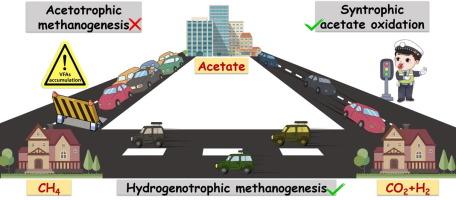Strengthening the syntrophic pathway for acetate oxidation-hydrogenotrophic methanogenesis by biogas stirring for effectively mitigating acidification in anaerobic digestion
IF 13.3
1区 工程技术
Q1 ENGINEERING, CHEMICAL
引用次数: 0
Abstract
Anaerobic digestion (AD) frequently encounters challenges such as acidification under high organic loadings, leading to system instability or failure. This study demonstrates that biogas stirring (RB) effectively mitigates acidification during the AD of FW (FW), outperforming traditional mechanical stirring (RM). The RB system sustained stable methane production, reaching 249.1 mL CH4/g VSadded/d, whereas the RM system encountered significant acidification, with a pH dropping to 5.0 ± 0.2, impeding methanogenesis. For sludge characteristics, biogas stirring in the RB system significantly decreased particle size to 78 μm, which were anticipated to facilitate mass transfer and substrate conversion. Focus on the microbial communities evolution, employing biogas stirring facilitated a rational microbial collaboration with the enhanced capability for volatile fatty acids (VFAs) conversion and methane production. In addition, Methanobacterium, a typical methanogen for hydrogenotrophic methanogenesis (HM), was predominant in RB, occupying in an important position (Centrality = 0.9232) in the microbial network. Furthermore, the increased H2 partial pressure enriched the concentration of F420 by 63.1 %, facilitating its uptake and supporting the growth syntrophic acetate-oxidizing (SAO) bacteria. The consequent activation of the SAO-HM pathway is key to rapidly restoring methane production post-acidification. The findings of this study revealed the underlying role of biogas stirring for SAO-HM pathway and provided a potential strategy to facilitate acidification alleviation in AD.

通过沼气搅拌强化醋酸盐氧化-养氢产甲烷的合成途径,有效缓解厌氧消化过程中的酸化问题
厌氧消化(AD)经常会遇到各种挑战,如在高有机负荷下酸化,导致系统不稳定或失效。本研究表明,沼气搅拌(RB)能有效缓解 FW 厌氧消化(AD)过程中的酸化,优于传统的机械搅拌(RM)。RB 系统可维持稳定的甲烷产量,达到 249.1 mL CH4/g VSadded/d,而 RM 系统则出现明显酸化,pH 值降至 5.0 ± 0.2,阻碍了甲烷生成。就污泥特性而言,RB 系统中的沼气搅拌使颗粒尺寸显著减小至 78 μm,这预计将促进质量传递和基质转化。在微生物群落进化方面,沼气搅拌促进了微生物的合理协作,增强了挥发性脂肪酸(VFAs)转化和甲烷生产的能力。此外,养氢型甲烷发生(HM)的典型产甲烷菌--甲烷杆菌(Methanobacterium)在 RB 中占主导地位,在微生物网络中占据重要位置(中心度 = 0.9232)。此外,增加的 H2 分压使 F420 的浓度提高了 63.1%,促进了其吸收并支持了合成营养型乙酸氧化(SAO)细菌的生长。因此,SAO-HM 途径的激活是酸化后迅速恢复甲烷生产的关键。这项研究的结果揭示了沼气搅拌对 SAO-HM 途径的潜在作用,并为促进厌氧消化(AD)中的酸化缓解提供了一种潜在策略。
本文章由计算机程序翻译,如有差异,请以英文原文为准。
求助全文
约1分钟内获得全文
求助全文
来源期刊

Chemical Engineering Journal
工程技术-工程:化工
CiteScore
21.70
自引率
9.30%
发文量
6781
审稿时长
2.4 months
期刊介绍:
The Chemical Engineering Journal is an international research journal that invites contributions of original and novel fundamental research. It aims to provide an international platform for presenting original fundamental research, interpretative reviews, and discussions on new developments in chemical engineering. The journal welcomes papers that describe novel theory and its practical application, as well as those that demonstrate the transfer of techniques from other disciplines. It also welcomes reports on carefully conducted experimental work that is soundly interpreted. The main focus of the journal is on original and rigorous research results that have broad significance. The Catalysis section within the Chemical Engineering Journal focuses specifically on Experimental and Theoretical studies in the fields of heterogeneous catalysis, molecular catalysis, and biocatalysis. These studies have industrial impact on various sectors such as chemicals, energy, materials, foods, healthcare, and environmental protection.
 求助内容:
求助内容: 应助结果提醒方式:
应助结果提醒方式:


